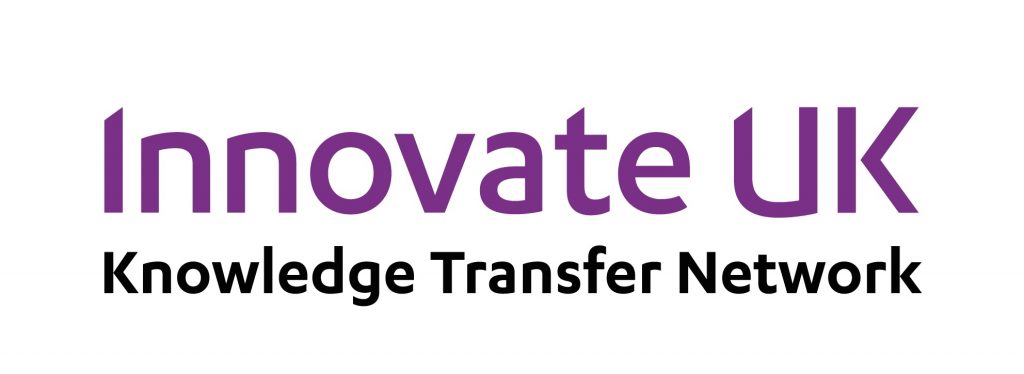Automating Composite Structure Inspections & Repairs
The Robotics Innovation challenge competition, delivered in partnership with ORE Catapult and the Knowledge Transfer Network, is supporting GE to identify innovative solutions to innovation challenges. The harsh environmental conditions that apply to an offshore wind turbine create the need for regular inspections, maintenance and repair of the blades and its subcomponents. GE seeks an inspection method that eases the job by eliminating human resource exposure to rope climbing.
Opportunity
Challenge opens
16/09/2019
Challenge closes
29/10/2019
Benefit
1 An introduction from GE Renewable Energy
GE Renewable Energy is a $15 billion business which combines one of the broadest portfolios in the renewable energy industry to provide end-to-end solutions for our customers demanding reliable and affordable green power. Combining onshore and offshore wind, blades, hydro, storage, utility-scale solar, and grid solutions as well as hybrid renewables and digital services offerings, GE Renewable Energy has installed more than 400+ gigawatts of clean renewable energy and equipped more than 90 percent of utilities worldwide with its grid solutions. With nearly 40,000 employees present in more than 80 countries, GE Renewable Energy creates value for customers seeking to power the world with affordable, reliable and sustainable green electrons.
GE Offshore Wind, a GE Renewable Energy business, is headquartered in Nantes, France, and has more than 600 employees in the world (with main offices in France, Spain, Germany, China and the US). GE Offshore Wind serves global markets and is the only offshore wind turbine supplier to have projects in Europe, Asia and the Americas. On March 2018, we announced a strategic investment plan to develop Haliade-X 12 MW, the most powerful offshore wind turbine to-date, to be assembled in Saint-Nazaire, with LM Wind Power blades to be manufactured in Cherbourg. The first prototype is currently being assembled in Rotterdam.
With a projected industry growth from 22 to 153 GW in the next decade, experts believe offshore wind will account for 15% of the global wind industry going forward, and by 2025, offshore wind could represent more than 15% of global wind installed capacity.
- 2 Products & Services - Offshore Wind
Offshore Wind contains 2 main platforms, the Haliade 6MW-150 and Haliade-X, currently the most powerful offshore wind turbine in the world featuring a 12 MW capacity generator (the world’s first), 220-meter rotor, a 107-meter blade designed by LM Wind Power, and digital capabilities.
1.2.1 Haliade 6MW-150
As of today, GE Offshore Wind is the only OEM on all 3 continents, accounting for 1GW of installations (incl. backlog):
- Europe:
- Merkur, DE: 396MW
- Osterild, DK: 6MW
- Belwind, B: 6MW
- LeCarnet, FR: 6MW
- St. Nazaire: 480MW (backlog)
- North America:
- Block Island, US: 30MW
- Asia:
- Fuqing Xinghua Bay, CH: 18MW
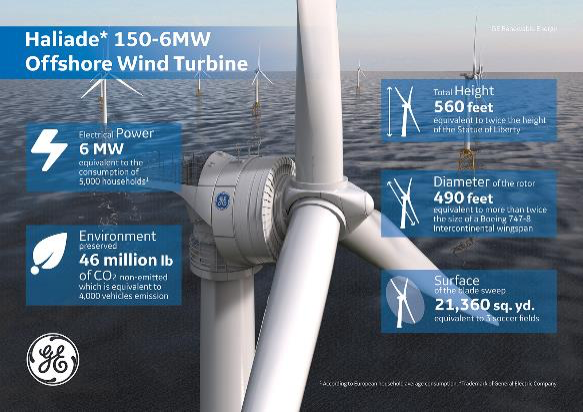
Figure 1 Haliade 6MW-150
1.2.2 Haliade-X 12MW-220
The validation unit of the Haliade-X is going to be installed in Rotterdam, NL for IEC Type certification, besides many other extended tests. The first commercial units will be installed in 2023.
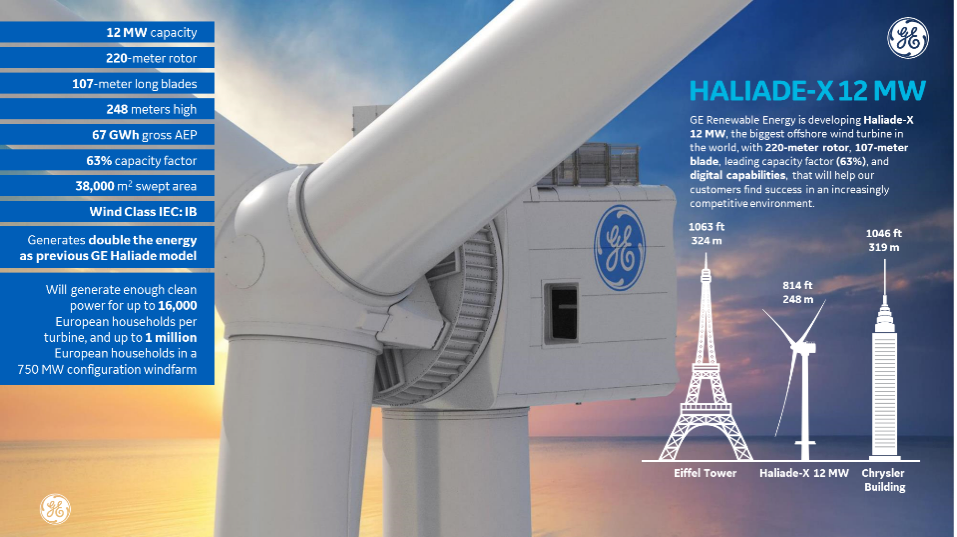
Figure 2 Haliade-X 12MW-220
1.2.3 Service & Digital
1.2.3.1 Wind Energy Turbine Service
Our team provides flexible and customised operations and maintenance support to fit specific customer needs. We offer tiered levels of service offerings ranging from remote monitoring to fully maintaining the customer's plant, as well as a wide range of performance-enhancing upgrades to keep turbines running smoothly. Whether a customer is looking for support with unplanned maintenance or interested in upgrading its farm or fleet with our digital applications, we can meet their needs.
Optimising wind power generation lifetime output for Offshore Wind
The long-term performance potential of a wind farm is only partially determined at the manufacturing and construction stages. The best design and construction will be of little benefit if the operating and maintaining service is not fully optimised. That is why GE operates a global network of local service centres and offers a full range of packages and services in order to:
- Enhance availability
- Improve energy generation
- Optimise component and system lifetime
The key to achieving these objectives lies in highly reliable products combined with effective planned maintenance, resulting in increased production. This is achieved thanks to carefully selected predictive and preventative service activities as well as suitable upgrades and retrofits.
In accordance with our clean power strategy, we always consider profitability and commercial excellence in the wider context of environmental, health and safety (EHS) matters.
Corrective Maintenance consists of repairing breakdowns or performing unscheduled emergency maintenance. Data analyses and equipment control enables us to determine any potential incidents in real-time. In order to minimise the impact of these corrective activities, predictive activities are carried out supported by a stock of spare parts and critical components, stored either at wind farms or in our warehouses.
Additionally, and as a complement to the activities mentioned above, predictive actions such as oil analyses, vibration measurements, and thermography etc. are also performed in order to anticipate any slowly-developing malfunctions to minimise any unforeseen breakdowns.
Finally, preventive maintenance refers to all maintenance actions that are programmed in the wind turbine maintenance manual (operations and regular inspections), which are necessary to guarantee the life of the machines and operation under optimum conditions.
1.2.3.2 Digital Solutions
Our customers’ operational strategy is what drives our digital products and lifecycle solutions. We focused on what matters most to the customer - outcomes that increase revenue, reduce costs, and lower risk. GE does this by applying data-driven insights, expert recommendations, and advanced field services through a single digital asset management platform.
GE combines physical product expertise with an end-to-end renewable energy analytics-based platform. Our renewable energy software and data analytics out-perform the competition because of our deep industry knowledge and hands-on experience. Our models are built on decades of experience operating renewable energy assets around the world, proprietary data, and the internal use and refinement by our services teams.
The Industrial Internet is helping companies reach new levels of productivity and gain a competitive edge. For renewable energy, this means digitising asset management and connecting data for improved reliability, enhancing operations to increase profitability, and innovating new business models to improve performance and scale for growth. But where to start?
GE’s Digital Wind Farm offerings help to deliver a full view of your enterprise with data consolidation and translation. This digital control allows you to take action by turning data from your renewable energy technology into insights through advanced analytics and recommendations—enabling smarter operational teams that keep your fleet running its best.
1.3 Robotics
Robots can be programmed to perform dangerous, dirty and/or repetitive tasks with consistent precision and accuracy. Industrial robots are increasingly used in a variety of industries and applications. They come in a wide range of models with the reach distance, payload capacity and the number of axes.
Inspections and necessary repairs of wind turbines off the coast are currently carried out by a crew of technicians, who face considerable safety risks in the course of their work due to the risks posed by extreme conditions, weather events and the height of the turbines. The process is doubly costly as a result of lost energy production during the period of downtime which must occur so maintenance activity can be carried out; and the daily expense incurred by crew transfer vessels.
In the next years GE Offshore Wind aims to develop robots, which can be used in the following areas:
- Inspection & repairs
- Repetitive tasks
- Confined space
Besides the specific areas of work, the integration of the robotics into the service plan and fleet engineering loop is critical to ensure effective usage of the robotics.
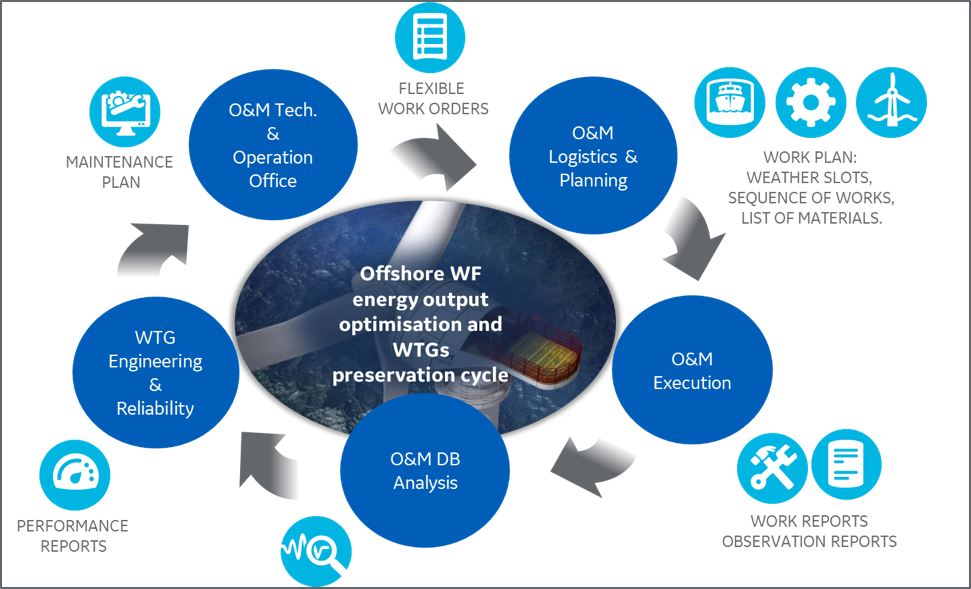
Figure 3 GE service plan and engineering loop
2 Blade Inspections & Repairs Challenge
The Robotics Innovation challenge competition, delivered in partnership with ORE Catapult and the Knowledge Transfer Network, is supporting GE to identify innovative solutions to innovation challenges. The winning business(es) in this competition will be given a commercial opportunity to deliver their solution to GE Offshore Wind, and to receive support from GE Offshore Wind, the ORE Catapult and the wider UK network.
Whilst not limiting the technologies from solution providers, it is expected that solutions would consider innovations from challenges, which are described in the following sections.
Successful applicants will be given an opportunity to pitch to GE Offshore Wind. The package may also include:
- Support from GE Offshore Wind
- Support in the development of a prototype or pilot
- Technical support
- A place at ORE Catapult events
- A potential business collaboration
2.1 Background
The harsh environmental conditions that apply to an offshore wind turbine asks for regular inspections and maintenance on the blades and its subcomponents. The current approach is to use rope climbers that are inspecting the blades manually and perform any activity like preventive or corrective manually. This process is very sensitive to weather conditions and thus may experience restrictions causing delays of schedules and induce unnecessary costs on waiting time. The periodic interval is usually 12 or 24 months for inspections and 36 months for some major maintenance on the leading-edge protection.
GE is seeking an inspection method that eases the job by eliminating human resource exposure to rope climbing by applying the highest safety and quality standards and guaranteeing full functionality of components. This may involve robotic technology that operates semi or fully self-sufficiently.
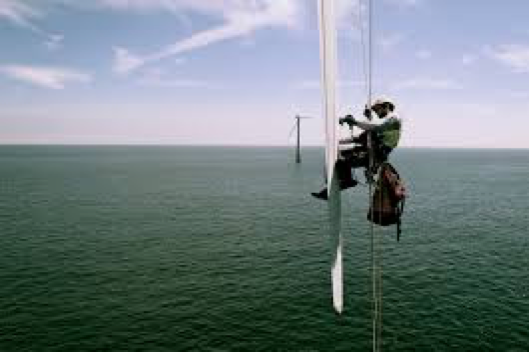
Figure 4 blade inspection/repair rope climbing
2.2 Scope
Develop a semi or fully autonomous device that is capable of performing the wind turbine blade maintenance requirements set out in the following sections (2.2.1, 2.2.2 and 2.2.3).
2.2.1 Blade Maintenance Requirements
The optimum best case solution should cover all of the listed requirements below, or combine as many as possible. Details of each requirement are to be further described and will have to follow the design specifications issued by the OEM.
2.2.1.1 Surface Inspections
Surface inspections today are performed in different ways. The traditional ways are either using rope climbers or a platform that allows human resource to physically inspect the blades. NCurrently the industry is moving towards drone inspections, but they have the disadvantage of only being able to take images to identify the condition of a blade. These images are processed by intelligent database algorithms to detect anomalies. However, drone images have limitations and may not provide the full condition of a blade (e.g. pollution may lead to incorrect assumptions). The preferred solution would be a device that has physical contact to the blade surface to determine the conditions. Those conditions need to be recorded and issued in a report.
2.2.1.2 Drain Hole inspection and cleaning
Each blade collects water inside, which risks damage, especially in the winter season if temperatures go below zero. Expansions of the water through freezing may lead to cracks or other damage. Therefore, each blade has a hole at the tip end to drain moisture from the inside to outside. It is essential that those holes are free and not plugged by debris or similar. Currently inspections need to be performed by either using a platform or rope climber. We aim to avoid this in future by using automated self-performing systems.
2.2.1.3 Lightning Protection System (LPS)
Blades are naturally exposed to lightning and therefore equipped with a protection system that consists of a receptor at the blade tip, which is connected by a conductor with the turbine structure and foundation grounding. The connection between the blade tip and ground must be inspected regularly to protect the blade from lightning damage. The procedure includes a visual check of the receptor conditions and a resistance measure of the ground connection, which needs to be recorded and filed. Inspections need to be performed today by either using a platform or rope climber. We aim to avoid this in future by using automated self-performing systems.
2.2.1.4 Self - detecting surface pollution and cleaning
Surface pollution of a blade can have a negative impact on the production performance of a wind turbine and ideally it should get cleaned at certain intervals. However, the positive effects of holistic surface cleaning are always in competition with energy losses from required downtime of operations. This needs to be well considered in detail by a solution provider. Today’s methods require platforms and cranes to perform a full clean and is only used in cases of extreme pollution. This challenge shall determine whether a self-sufficient system can improve the business case. As a minimum we would expect robotic solutions carrying out a surface, drain hole or LPS inspection to also record and clean heavy pollution spots, particularly grease spots.
2.2.1.5 Internal structural inspections for cracks or anomalies
Like the outer surface inspection, an internal inspection for cracks or anomalies on the structure is required. The blades can be accessed from the inside of the hub through an inspection hole. The blades can be positioned in any way, i.e. horizontal, vertical or in-between for the inspection. Today's inspection method is carried out by rope climbers going inside the blade. The inside of a blade is defined as confined space and may contain toxic fumes from the glue used to manufacture the blade, which need to be considered for this operation. The preferred solution would be a device that does the inspection without human resources exposed to the above-mentioned risk. The conditions of the inside need to be recorded and issued in a report. This task may also be combined with the outside inspection by a suitable scanning method that has the capability to identify any anomaly of the inner structure of a blade.
2.2.1.6 Leading edge protection (LEP) inspection/repair/renew
The LEP is a separately applied strip of material that is located at the front side of the blade and usually glued onto it and is impacted the most for wear since it is directly cutting into the rain, dust and other impacting environmental factors. Thus, a regular inspection of its condition is required. In cases where the LEP needs to be repaired or renewed, a rope climber needs to be used for this task. As described above, this risk should be avoided and shall be taken over from a robotic device that is self-sufficiently executing this task. The sequence begins with removal of the old LEP (usually a special tape), cleaning of the surface and application of a new LEP. The inspection of the LEP shall be part of the surface inspection as described above. The repair/renew of the LEP can be developed as a stand-alone task since it may be time consuming and does require a dedicated campaign.
2.2.2 Operational Requirements
- Should operate semi or fully self-sufficiently
- All waste and disposals are carefully collected and do not enter uncontrolled into the environment
- There is a need to issue a detailed report, for each task as listed under chapter 2.2.1, with adequate data to understand a) condition of the component with recommended actions after any inspection or b) in cases of a repair a detailed report explaining the performed task
- Installation time for the device and associated equipment shall be <30 minutes excluding mobilisation and demobilisation
- The device shall be capable to perform each individual task mentioned in 2.2.1 across 6 blades in 12 hours including mobilisation/demobilisation
- The operating team shall be limited to 2 technicians for the setup and 1 technician for the operation of the device.
2.2.3 Operational Conditions
The device and associated equipment must be capable of operating in harsh offshore conditions and meet the following criteria:
- Waterproof and shock resistant
- Resistant against dust, grease, oil, glycol
- Minimal maintenance and calibration efforts., e.g. maintenance and calibration shall not be below 12 months with a desired interval of 24 months
- Able to work a minimum of 12 hours constantly in a high humidity outdoor environment with a temperature range of -10°C to +40°C, and best case up to 12m/s wind speed
- Minimal training and educational effort shall be required to operate the device.
2.3 IP and Potential Commercial Route
- Prior to any exchange of proprietary information, a non-disclosure agreement shall be in place between any party involved
- Any new developed IP that was born from the innovation challenge shall be subject to a mutual agreement between developer and GE
- Existing background IP associated with a potential solution will remain with Solution Provider(s)
- Any commercial deployment of a transferred solution or newly developed solution, through licensing, joint venture, partnership or direct investment, will be subject to the commercial agreement between the Solution Provider(s) and GE.
2.4 Deployment Timescale
- Launch of the Competition: 16-Sep-2019
- Deadline for applications: 25-Oct-2019
- Selection and notification of finalists: 8-Nov-2019
- F2F meeting/pitch opportunity for finalists: w/c 11-Nov-2019
- Selection of winners & signed LOI: 15-Nov-2019
- Refinement of solutions: w/c 18-Nov-2019
- Announcement at Offshore Wind Europe Conference: 26-Nov-2019
- Sign contracts & start project: Nov/Dec’19
2.5 Eligibility and assessment criteria
Entrants to this competition must be:
- Established businesses, startups, SMEs or individual entrepreneurs
- UK based or have the intention to set up a UK base
Applications will be assessed on:
- Relevance to the topic
- Innovative nature of the subject
- Coherence of the proposed business model
- Feasibility/ economic viability
- Development potential
- Maturity of project/solution
- Ability to launch project quickly/Ease of implementation
- Price/quality ratio
- Suitability for the UK Market (Inc. building regulations and certification etc.)
- Project plan and funding requests
2.6 Funding Scheme
The funding scheme between the Solution provider and GE Offshore Wind will be defined on an individual base. It could consider venture capital, funding tests, etc. The funding will be limited firstly to financial years 2019/2020 and depending on project progress and success it might be extended even after 2020.
This challenge is brought to you by:

.png)
